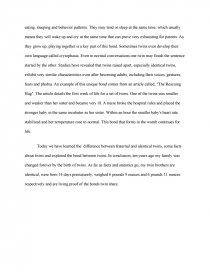Twins
Essay by review • March 2, 2011 • Essay • 959 Words (4 Pages) • 1,378 Views
Ten years ago, my mom and dad decided to have a second child. Shortly after becoming pregnant, my mother began to have some complications. She met with her obstetrician and after some blood tests and a sonogram; they were told that she would most likely miscarry. When a woman becomes pregnant the levels of the human growth hormone in her blood called HCG, should double each day. The HCG levels in her blood were only going up by 50 percent, which led everyone to believe the pregnancy would fail. They waited another week, having blood tests done every other day and then went for another sonogram. To everyone's amazement, there was not only one baby in the sonogram, there were two. This explained everything. The blood tests were only taking into consideration one baby not two and the complications my mother had were typical when dealing with a multiple pregnancy. From that moment on we all knew our life would be different. Whether dressed alike in a baby stroller or 10 years old walking through the mall, twins fascinate us. The term "twin" comes from the Ancient Greek word for twine meaning "two together". Today, we will discuss this phenomena, specifically fraternal and identical twins, the difference between the two, some facts about twins and the bond between them. The information we will be sharing today comes from TWINS magazine, multiplebirths.com and the CDC.
The easiest way to tell if twins are fraternal or identical is just by looking at them. If one is a boy and one is a girl you can rule out identical. In order to distinguish between these types of twins we must know how they are formed. Fraternal twins result when two eggs are released by the mother at the same time and each egg is fertilized by a different sperm. This is referred to as dyzygotic. The babies develop in separate placentas. In rare instances this can mean a set of twins can have two different fathers. Identical twin result when a single egg splits at the time of conception. This is referred to as monozygotic. These babies share a single placenta. Conjoined or Siamese twins occur when this egg fails to split completely. However, just because twins are of the same sex and look very similar does not mean they are identical. Testing the placenta after birth and DNA testing are the only ways to determine if same sex twins that look exactly alike are truly identical.
Now that we know how to determine if twins are fraternal or identical, let's check out some facts about twins. Only 1 in 35 births are identical twins. Since the 1980's, twin births have risen by over 80 percent. The most obvious reason for growing birthrates of twins is the use of fertility drugs. According to the CDC, more twins were born to women 45-49 years of age in 1997 than during the entire decade of the 1980's. Parents who conceive twins without the help of fertility drug are 60 percent more likely to conceive twins again. That's why many younger families may have a set of twins, a single child and then another set of twins. Twins that reach 37 of the normal 40 weeks in the womb are considered full term, but most are born about 20 days premature. The average birth weight for twin is 7 pounds 6 ounces if they go full term. Identical twins have the same DNA, although their fingerprints and teeth marks vary slightly. 25 percent of fraternal twins
...
...


